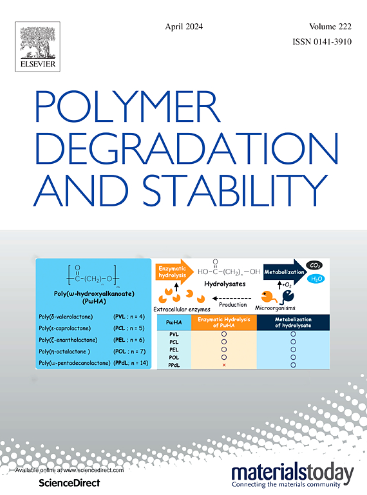Morphological effect on high-voltage insulation properties in polypropylene/elastomer binary blends: An experimental and simulation study
IF 6.3
2区 化学
Q1 POLYMER SCIENCE
引用次数: 0
Abstract
Polypropylene (PP)/elastomer blends have been widely studied as promising insulation materials for high-voltage (HV) power cables. Among various factors, the size of elastomer domains critically influences their electrical insulation performance, such as resistivity and breakdown strength (BDS). However, this relationship remains poorly understood. This study investigates the effect of the polyolefin elastomer (POE) domain size on the high-voltage insulation properties of the PP/POE blend. The binary blends were prepared through melt-blending of the PP and POE at the different mixing temperature from 185 to 235 °C. As an increase of the mixing temperature, the size of dispersed POE domain was linearly increased due to the viscosity differences between the PP and POE. In addition, the tensile strength, elongation, volume resistivity, and DC breakdown strength were decreased with mixing temperature, which were thus correlated with the POE domain size. The BDS values derived from simulations were consistent with those calculated via the Power law equation, showing a decline in BDS with increasing mixing temperature. Analysis of electric field distribution and space charge accumulation indicated that smaller POE domains more effectively mitigate electric field imbalances, delaying BD compared to larger domains. This study highlights the significant role of morphology in determining the insulation performance of polymer blends, providing valuable insights for the design of HV insulation materials.
求助全文
约1分钟内获得全文
求助全文
来源期刊

Polymer Degradation and Stability
化学-高分子科学
CiteScore
10.10
自引率
10.20%
发文量
325
审稿时长
23 days
期刊介绍:
Polymer Degradation and Stability deals with the degradation reactions and their control which are a major preoccupation of practitioners of the many and diverse aspects of modern polymer technology.
Deteriorative reactions occur during processing, when polymers are subjected to heat, oxygen and mechanical stress, and during the useful life of the materials when oxygen and sunlight are the most important degradative agencies. In more specialised applications, degradation may be induced by high energy radiation, ozone, atmospheric pollutants, mechanical stress, biological action, hydrolysis and many other influences. The mechanisms of these reactions and stabilisation processes must be understood if the technology and application of polymers are to continue to advance. The reporting of investigations of this kind is therefore a major function of this journal.
However there are also new developments in polymer technology in which degradation processes find positive applications. For example, photodegradable plastics are now available, the recycling of polymeric products will become increasingly important, degradation and combustion studies are involved in the definition of the fire hazards which are associated with polymeric materials and the microelectronics industry is vitally dependent upon polymer degradation in the manufacture of its circuitry. Polymer properties may also be improved by processes like curing and grafting, the chemistry of which can be closely related to that which causes physical deterioration in other circumstances.
 求助内容:
求助内容: 应助结果提醒方式:
应助结果提醒方式:


